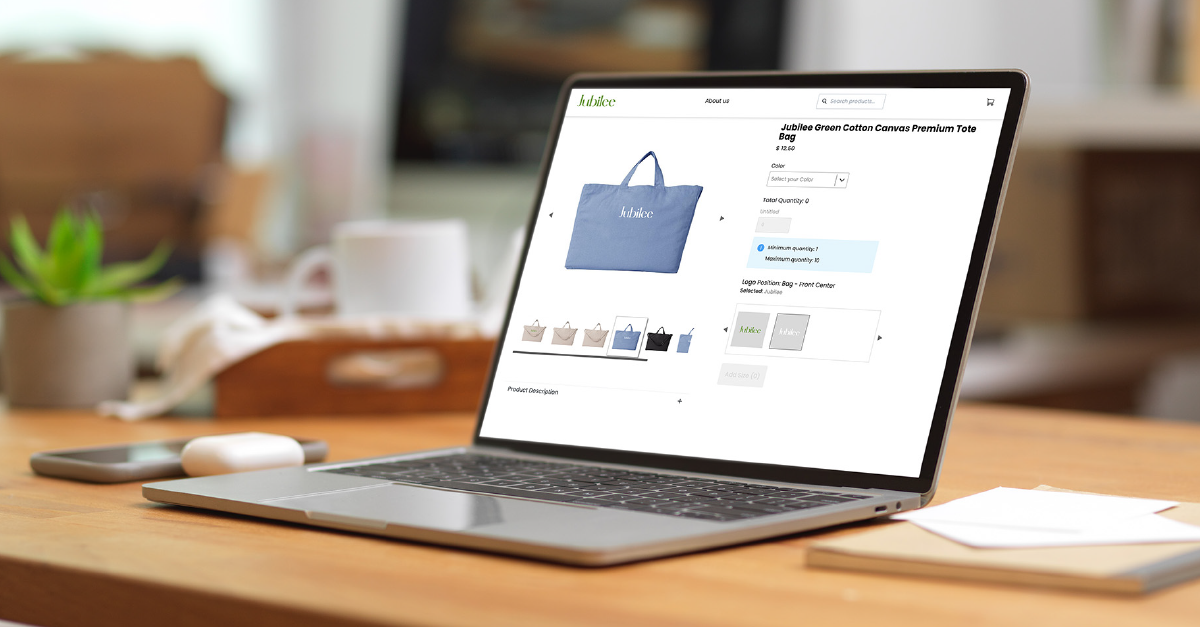4 min read
Setting Up an Online Store: The Power of On-Demand Production
Suz Pathmanathan
:
Apr 30, 2024 4:08:12 AM

Thinking of setting up an online store to sell your promotional products? According to an Environmental Protection Agency report, about 5 billion pounds of waste are generated annually from unsold or unusable promotional products, highlighting the need to think differently about what’s being sold and how.
There are a few reasons why promotional products so often wind up in landfills:
- Low perceived value: Promotional items are often made cheaply and not for someone’s specific needs. People are more likely to toss something they don't find valuable or don't use regularly.
- Material choice: Many promotional products are made from non-biodegradable materials, like plastic. This means they take hundreds or even thousands of years to break down, filling up landfills.
- Overproduction: Promotional products are frequently handed out in bulk at events or conferences. Since they aren't always targeted to specific needs, people may end up with multiples of similar items they don't actually need.
- Short lifespan: Promotional products are designed to be low-cost marketing tools, and sometimes, that means they're not built to last. They may break easily or become outdated quickly, leading people to discard them.
There are ways for your business to promote itself more sustainably. You could focus on higher-quality, reusable items or donate them to charity in the recipient’s name instead of giving out physical products.
You could also consider on-demand production.
The old ways of mass production and inventory hoarding are giving way to smarter, more flexible strategies. On-demand production and on-demand stores are at the forefront of this revolution, offering not just a new way to do business but a better one.
We all know the score with the traditional model. The promotional products industry has relied on bulk manufacturing. Companies would estimate demand, produce large quantities of items, and store them until sold. This model has several flaws: it ties up capital in unsold stock, leads to overproduction, and often results in waste when products become outdated or remain unsold.
For sales reps in the industry, bulk orders can also lead to a bulky headache! With on-demand, there’s no need to hold onto large quantities of stock that might not sell through, which minimizes dead stock and wasted inventory costs. This should be music to the ears of distributors paying out of pocket for products.
On-demand also allows reps to respond to client requests quickly, especially for urgent needs or last-minute campaigns, offers a wider range of customization options without the commitment of bulk minimums, and caters to smaller orders, which can be attractive to new clients or those with limited budgets.
Ordering exactly what the client needs also reduces the risk of overstock or understock situations and gives a greater understanding of individual preferences. This knowledge can be applied to the sample order process, which, with on-demand production, allows samples to be easily ordered and presented to clients or prospects to test the quality before committing to a larger order.
Zazzle, a leader in on-demand retail, uses real-time data and customer input to create products that are already sold the moment they’re made. This eliminates the risk of overproduction and reduces storage needs, cutting down costs significantly.

The real beauty of on-demand production lies in its scalability and flexibility. As mentioned above, using this method, a company can test a new product online without a massive upfront investment in inventory. If the product catches on, they can increase production with minimal risk. This agility is critical in an industry driven by trends and customer preferences.
For instance, when Nike launched a limited edition sneaker for a specific event, they used an on-demand store to manage orders and production. This not only ensured that every sneaker produced already had a buyer but also created a buzz and exclusivity around the product, enhancing brand value.
These stores also allow companies to respond quickly to market changes.
With Brikl, the process of setting up an online store is simple
- Contact us to register for our new, next-gen dashboard.
- Choose your products and set up your catalog.
- Add decoration and set your products up for sale.
- Create your store and select the catalogs you want to make shoppable.
- Sell on-demand.
Think bulk orders are the only way to secure a competitive price? Think again!
-
Volume Discount Threshold:
By calculating the "volume discount threshold" (the order quantity at which on-demand becomes cheaper than bulk), sales reps can highlight the point where on-demand becomes more cost-effective for smaller orders. This can be a powerful tool for demonstrating the value proposition of on-demand, especially for clients who don't necessarily need the cost savings associated with large upfront purchases. -
Tiered Pricing Structures:
On-demand doesn't have to be an all-or-nothing proposition. Sales reps can create tiered pricing structures that combine bulk discounts for larger orders with competitive on-demand pricing for smaller quantities. This caters to a wider range of client needs, providing both cost savings and flexibility. -
Focus on Value Beyond Price:
Bulk discounts incentivize larger orders, but on-demand can emphasize other benefits like reduced waste, faster turnaround times, and increased customization. For environmentally-conscious clients or those with specific branding requirements, these advantages can outweigh the cost savings of bulk purchases. -
Target Clients Who Value Flexibility:
The on-demand model is ideal for clients who don't need or want to commit to large inventories. Sales reps can target these clients by showcasing the benefits of on-demand, such as reduced storage costs and the ability to order exactly what they need when needed.
Etsy, a global marketplace for unique and creative goods, provides sellers with tools and insights to capitalize on seasonal trends. By analyzing search data and consumer behavior, Etsy identifies emerging trends and shares this information with its sellers, enabling them to tailor their offerings to meet current demand.

If you haven’t heard it from your customers, you may have noticed the trend in industry media or at events. Consumers are increasingly aware of and concerned about the environmental impact of their purchases. Companies that use on-demand production significantly reduce waste and resources by producing items only when there is a demand.
This production often utilizes digital technology, such as digital printing, which is generally less wasteful than traditional printing methods. This not only helps reduce carbon footprint but also aligns with the growing consumer preference for environmentally responsible companies.
On-demand production models like those used by Teespring and Redbubble can reduce waste by up to 90% compared to traditional manufacturing processes. The traditional retail model often leads to overproduction—estimates suggest that 20% to 30% of clothing produced in a traditional setup goes unsold. On-demand production virtually eliminates this excess, as everything produced is already purchased.
This production often utilizes digital technology, such as digital printing, which is generally less wasteful than traditional printing methods. This not only helps reduce carbon footprint but also aligns with the growing consumer preference for environmentally responsible companies.
As we look ahead, the trajectory for the promotional products industry is clear. The shift towards on-demand production and on-demand stores is not merely a trend but a sustainable, adaptable, and economically viable pathway forward – for your business, for your customers, and for the planet. It’s kind of a win-win! This model not only meets the current needs of efficiency and customization but does so in a way that is significantly more sustainable than traditional practices. Talk to us to find out more.





